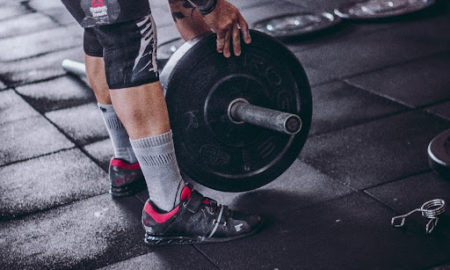Milo of Kroton, six-time Olympic wrestling champion (540 to 516 B.C.), was the first athlete reported to have combined progressive-resistance training with a high-protein diet. Legend has it that four years out from the Olympics Milo purchased a calf. Each day he would hoist the calf on his shoulders and carry it around the Olympic stadium. As the calf grew, it placed new stressors on Milo’s muscles, enhancing his size and strength for the Olympic competition.
Perhaps most intriguing about Milo was his extremely high protein intake, which was said to total more than 20 pounds of meat daily. That represents an enormous feat, considering the fact that one pound of steak contains 136 grams of protein.
While thousands of years have passed since Milo flourished, science has only explored the effects of high-protein diets in the past few decades. We’re starting to get a handle on exactly how much protein resistance-trained athletes need.
Protein Requirements: What the Studies Say
Bodybuilders may require more protein for a number of reasons, including increased need for the repair of muscle damage as well as sparing skeletal muscle for fuel use during prolonged exercise—particularly when resistance training is combined with cardio.
Currently the determination of nitrogen balance is the most frequently used method of ascertaining protein requirements.1, 2, 3 Amino acids contain approximately 16 percent nitrogen, and when they’re metabolized, the nitrogen group is removed and excreted from the body. The nitrogen-balance technique subtracts nitrogen taken in as protein from nitrogen lost from the body. When you’re eating maintenance calories and the amount of nitrogen taken in equals the amount of nitrogen lost, then your protein needs are said to be met.
Studies based on that calculation have found that sedentary individuals (e.g., bon-bon-eating couch potatoes) require only 0.8 grams of protein per kilogram of bodyweight, or 0.37 grams per pound. In contrast, breakthrough research in the late ’80s and early ’90s found that endurance athletes and bodybuilders required a much greater amount of protein than sedentary individuals, ranging from 1.2 to 2.2 grams of protein per kilogram of bodyweight to maintain nitrogen balance.1, 3, 4 What’s more, a number of studies have found that eating more protein leads to greater increases in squat strength,5 bench press power and hip sled performance,6 as well as muscle mass.7
Critical Factors Affecting Protein Needs
One of the more critical factors affecting bodybuilders’ protein needs is the phase of training they’re in. In the off-season, for example, calories are plentiful, and cardio is generally a lesser priority. Precontest cardio, however, can last as long as two hours a day, and calorie restriction is a higher priority. Studies show that a restriction of calories can increase protein needs by up to 75 percent. In addition, research suggests that cardiovascular training can dramatically increase protein needs, perhaps even more than weightlifting. That’s because cardio is the number-one activity known to use musculoskeletal protein as fuel. Accordingly, protein needs are greater for a calorie-restricted weightlifting and cardio pumping athlete—a.k.a. a precontest bodybuilder.
Upping Your Protein Can Do More Than Just Build Muscle
Amino acids are generally cited only for their role as building blocks of body tissues, including muscle, but they serve many other purposes. The amino acid leucine has a central role in stimulating protein synthesis,8 decreasing protein breakdown,9 maintaining blood glucose between meals and optimizing insulin signaling.10 And what’s critical for you is that those effects are only maximized when you’re on a higher protein diet—1.2 to 2.2 grams per kilogram of bodyweight.
What is perhaps more fascinating is that a high-protein diet increases fat loss as well as preserves muscle mass during periods of calorie restriction, as opposed to a higher carb diet.10 Reasons for that include the fact that protein increases the feeling of fullness following a meal more than fat and carbs do. Further, the digestion of protein requires more energy (up to 40 percent of the calories in the protein) than carbohydrate (10 percent) or fat (near zero percent). Research from the University of Illinois indicates that individuals attempting to become leaner should eat at least a gram of protein per 1.5 grams of carbohydrates.
How to Take in Protein in a 24-Hour Period
Layne Norton and Gabe Wilson recently published a paper arguing that muscle mass is regulated on a per meal basis and not over a 24-hour time period.11 Therefore, to determine your optimal protein intake, you need to know the optimal meal size and frequency.
Concerning meal size, research from the University of Illinois has shown strong evidence that the amino acid leucine is the key trigger for stimulating muscle protein synthesis.12 The question then is, how much leucine should you have at each meal? Research suggests that protein synthesis is maximized at approximately three to four grams of leucine per meal. So total protein per meal should be based on the quantity of leucine in your protein. In general, the leucine content in milk-based products ranges from 10 percent (milk isolate, casein) to 12 percent (whey). Meat- and egg-based products contain approximately 8 to 9 percent leucine, and proteins such as wheat and soy contain 6 to 7 percent leucine. If you eat whey, you’ll need only about 27 grams of protein to maximize muscle growth, whereas you’d need twice as much if you were to get protein from wheat.
Okay, you now know how to optimize protein synthesis at each meal, but you’re unsure how often you should eat. Bodybuilders typically have six to 10 complete meals—fat, carb, protein, fiber—per day. But is that optimal? Research has shown that while amino acids are still elevated five hours after a complete meal, protein synthesis is elevated only for the first three hours.12 That’s consistent with research demonstrating that a constant infusion of amino acids over six hours elevated protein synthesis for only two hours.13 It appears that the body gets “smart” and shuts protein synthesis down after two to three hours of amino acid concentration.
Those findings have led to the protein stat theory, which suggests the existence of a protein “stat” that senses changes in blood concentrations of amino acids. The interesting thing is that it responds to increases in amino acids by upping protein synthesis but becomes desensitized if concentrations of amino acids remain constant for more than a few hours. So keeping amino acids in the blood constant by eating small, frequent meals may very well result in a loss of response to the aminos’ stimulatory effects on muscle protein synthesis. What’s a bodybuilder to do?
Consider that taking in the branched-chain amino acids—leucine, isoleucine and valine—or a whey-protein isolate by itself or with an easily digested, lowfat, low-fiber carbohydrate source like a granola bar can raise extracellular amino acid concentration much more than if you ate a complete meal—possibly reinitiating protein synthesis. So it makes sense to space out your whole meals to every four to six hours and add a fast-digesting whey-protein isolate or BCAA supplement—three grams of leucine and one gram each of valine and isoleucine—between meals. Adding a low-fiber, easily digested carbohydrate may also prove beneficial.
Conclusions and Practical Applications
It should be obvious that bodybuilders require greater amounts of protein than sedentary individuals. In general, nitrogen balance studies suggest a daily range of 1.2 to 2.2 grams of protein per kilogram of bodyweight. We suggest that bodybuilders get that much protein over four to five whole meals, each separated by four to six hours. We further advocate choosing protein based on its leucine content. Popular sources include chicken (7.5 percent leucine), beef and fish (8 percent leucine), eggs (8 to 9 percent leucine), milk (10 percent leucine), casein (9 percent leucine) and whey (12 percent leucine).
If you’re eating beef, you’d need 40 grams of protein to optimize protein synthesis at 8 percent leucine, while if you’re taking whey, you may need only 27 grams. Finally, we recommend a whey-protein isolate or branched-chain-amino-acid mixture, perhaps combined with 20 to 30 grams of carbs between meals.
Now, before you turn to the next great IRON MAN article, mix yourself an amino acid cocktail. In fact, now that we are done writing this article, that’s precisely what we intend to do.
A delicious combination of micellar casein and whey proteins that’s formulated to provide the ratio of casein and whey proteins found in human mother’s milk. The addition of egg protein rounds out the high-quality protein formula necessary for growth and repair. Save with the six-pack!
Click Here for More Info
Editor’s note: Gabriel Wilson is completing his Ph.D. in nutrition with an emphasis on optimal protein requirements for muscle growth and is a researcher in the Division of Nutritional Sciences, University of Illinois, Urbana. He is vice president of the Web site ABCBodybuilding.com. Jacob Wilson is a skeletal-muscle physiologist and researcher in the Department of Nutrition, Food, and Exercise Science, Florida State University, Tallahassee. He is president of the Web site ABCBodybuilding.com.
References
1 Lemon, P.W., et al. (1992). Protein requirements and muscle mass/strength changes during intensive training in novice bodybuilders. J Appl Physiol. 73:767-75.
2 Rand, W.M., et al. (2003). Meta-analysis of nitrogen balance studies for estimating protein requirements in healthy adults. American J Clin Nutr. 77:109-27.
3 Tarnopolsky, M.A., et al. (1988). Influence of protein intake and training status on nitrogen balance and lean body mass. J Appl Physiol. 64:187-93.
4 Wilson, J., and Wilson, G.J. (2006). Contemporary issues in protein requirements and consumption for resistance trained athletes. J Int Soc Sports Nutr. 3:7-27.
5 Falvo, M.J., et al. (2005). Effect of protein supplementation on strength, power and body composition changes in experienced resistance-trained men. Med Sci Sports Exercise. 37:Suppl 45.
6 Vukovich, M., et al. (2004). Effect of protein supplementation during a six-month strength and conditioning program on muscular strength. Med Sci Sports Exer. 36(5):S193.
7 Burke, D.G., et al. (2001). The effect of whey protein supplementation with and without creatine monohydrate combined with resistance training on lean tissue mass and muscle strength. Int J Sport Nutr Exerc Metab. 11:349-64.
8 Anthony, J.C., et al. (2000). Leucine stimulates translation initiation in skeletal muscle of postabsorptive rats via a rapamycin-sensitive pathway. J Nutr. 130:2413-9.
9 Combaret, L., et al. (2005). A leucine-supplemented diet restores the defective postprandial inhibition of proteasome-dependent proteolysis in aged rat skeletal muscle. J Physiol. 569:489-99.
10 Baum, J.I., et al. (2005). Leucine reduces the duration of insulin-induced PI 3-kinase activity in rat skeletal muscle. Am J Phys. 288:E86-91.
11 Norton, L.E., Wilson, G.J., et al. (2008). Effects of four different isonitrogenous protein sources differing in leucine content on muscleprotein synthesis. Experim Biol. Supp.
12 Norton, L., and Wilson, G.J. (2009). Optimal protein intake to maximize muscle protein synthesis. AgroFood Ind Hi-tech. 2:54-67.
13 Bohe, J., et al. (2001). Latency and duration of stimulation of human muscle protein synthesis during continuous infusion of amino acids. J Physiol. 532:575-9. IM

















You must be logged in to post a comment Login